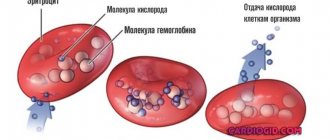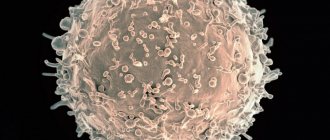Monocytes are the largest immune cells of all types of white blood cells and play an important role in protecting against bacteria and inflammation. What does an elevated monocyte count mean for your health? What factors can reduce their number? Find out about this in the article.
The article is based on the findings of 68 scientific studies
The article quotes authors such as:
- Rockefeller University, New York, USA
- Necker Hospital, Paris, France
- Department of Cell Biology and Genetics, Erasmus University Medical Center, Rotterdam, The Netherlands
Please note that the numbers in parentheses (1, 2, 3, etc.) are clickable links to peer-reviewed scientific studies. You can follow these links and read the original source of information for the article.
What are monocytes?
The front line of defense for your immune system
Monocytes are the largest type of white blood cell.
They help fight bacteria, viruses and other infections in your body. Along with other types of white blood cells, monocytes are a key part of your immune response. Only about 1% of your blood contains white blood cells, but they play a huge role in protecting against disease. Approximately 2 to 10% of all leukocytes are monocytes. (1) Your bone marrow produces monocytes and releases them into your bloodstream. Once they reach tissues in your body, they are called macrophages . There they isolate and devour germs and other harmful microorganisms. They also get rid of dead cells and promote the immune response. After leaving the bone marrow, monocytes circulate in the blood for several days before they enter tissues where they become macrophages or dendritic cells. (1, )
An example of how monocytes from the blood move into
an atherosclerotic plaque , becoming macrophages.
Monocytes adhere to the endothelium of blood vessels at sites of tissue damage, which leads to their activation and migration into the subendothelial space. Upon tissue entry, the monocyte differentiates into a macrophage. (source) Monocytes protect against viral, bacterial, fungal and protozoal infections. They kill microorganisms, absorb foreign particles, remove dead cells and enhance the immune response. (, 1, , )
However, they may also be involved in the development of inflammatory diseases such as arthritis and atherosclerosis. In this article, we'll take a closer look at how monocytes work and how they may be involved in disease. (, , )
Monocyte formation
All blood cells come from common parent cells called hematopoietic stem cells . In adults, blood cells are produced primarily in the bone marrow; this process is called hematopoiesis. The process of producing monocytes in particular is called myelopoiesis . (, )
Mechanisms of myelopoiesis (monocyte formation) during homeostasis and during different phases of infection and inflammation, illustrating important feedback loops between affected tissues and bone marrow.
Myelopoiesis is subject to a complex regulatory system, including such factors as:
- Transcription factor SPI1 (, , , )
- Cytokines: SCF (stem cell factor), GM-CSF (granulocyte-macrophage-colony-stimulating factor), M-CSF (macrophage colony-stimulating factor, CSF1), cytokines IL-3 and IL-6, and interferon IFN-gamma. (, , )
Monocytes live on average 3 days before undergoing apoptosis (programmed cell death). They live longer during periods of high inflammation; as soon as the inflammation disappears, monocyte death occurs. Such programmed death is necessary to prevent aggressive actions of immune cells from continuing inflammation and creating an autoimmune reaction. (, )
Normal monocyte count
Normal ranges for monocytes can be expressed in several different standard units of measurement. Ask your doctor to help you interpret lab results.
Normal Monocyte Ranges:
- 0.2 – 0.8 x10^9/l (laboratory reference values 0.08 – 1.5x10^9/l)
- 1 – 10% (laboratory reference values 4 – 12.5%)
Monocyte counts in normal ranges help reduce the risk of developing and poor outcomes:
- viral, bacterial and fungal infections ()
- heart disease ()
- obesity()
- diabetes ()
- increase in mortality ()
Elevated monocyte count
Monocytosis is a condition in which the number of monocytes circulating in the blood increases to more than 0.8x10^9/L in adults.
Diseases with elevated monocyte levels
- Circulatory disorders (myelodysplastic disorders, acute monocytic, chronic myelomonocytic leukemia, Hodgkin and non-Hodgkin lymphoma) (, , )
- Infections (tuberculosis, viral infections, bacterial endocarditis, brucellosis, malaria, syphilis) (, , , , )
- Autoimmune diseases (systemic lupus erythematosus, rheumatoid arthritis, inflammatory bowel disease) (, , )
- Sarcoidosis ()
- Malignant tumors (ovary, breast, rectum) ()
- Heart attack - infarction ()
- Appendicitis ()
- HIV infection
- Depression()
- Obesity ()
- Severe pneumonia ()
- Alcoholic liver disease ()
Monocytosis most often occurs during and after chronic inflammation or infection. () However, several other problems may be associated with monocytosis: heart disease, depression, diabetes and obesity. (, , )
The most common conditions and diseases associated with high monocyte levels are:
- Chronic (long-term) inflammation of any etiology ()
- Infections such as tuberculosis, malaria and syphilis (, , )
Monocytes are involved in human disease both directly through their functional effects and indirectly through their differentiation into macrophages . Diet influences the number of nonclassical monocytes, monocyte migration, and cytokine production, the effects of which are counteracted by fasting. Additionally, the epigenetic landscape is altered by metabolites in a process called innate immune memory. In atherosclerosis, monocytes differentiate into foam cells, which secrete proinflammatory cytokines and chemokines, accumulate lipids, and possibly participate in calcification. Monocytes exhibit high heterogeneity and their functions can be impaired, as in COPD , while the location of monocytes appears to be critical in lung cancer , with monocytes close to tumors being immunocompromised. Finally, monocytes infiltrate the brain in neurodegenerative diseases such as Alzheimer's disease .
(source) Few symptoms of inflammatory diseases are associated with monocytosis itself. According to many scientists, such symptoms arise from diseases associated with the development of monocytosis. () These symptoms consist of: fever (), pain (), tissue swelling. ()
Monocytosis in children
An increase in monocytes in childhood is also often associated with infectious pathologies, mainly of a viral nature. If monocytosis is diagnosed based on a blood test, this means that the body is actively fighting disease-causing processes.
Also, a similar condition is observed with helminthic lesions - enterobiasis, ascariasis and others. After the destruction of helminths, the content of monocytes returns to normal. The cause may also be associated with tuberculosis, but such pathologies are rare. Monocytosis can be observed due to oncological processes. The most common are leukemia and lymphogranulomatosis.
Other common reasons:
- poisoning;
- allergic reactions;
- inflammation in the gastrointestinal tract;
- autoimmune pathologies;
- rheumatoid type arthritis;
- Crohn's disease;
- infections due to surgical interventions.
Low monocyte count (monocytopenia)
With monocytopenia, the number of monocytes circulating in the blood decreases to less than 0.2 × 10^9/L in adults. Monocytopenia itself does not appear to cause symptoms, and patients usually experience only symptoms associated with the associated condition. Similar symptoms may include fatigue and fever. (, )
Diseases and conditions with low monocyte levels
- Aplastic anemia ()
- Leukemia (hairy cell leukemia, chronic lymphocytic leukemia) ()
- Carrying out chemotherapy ()
- Radiation therapy ()
- monoMAC syndrome (monocytopenia and mycobacterial infection) ()
- Severe burn injuries ()
- Rheumatoid arthritis ()
- Systemic lupus erythematosus ()
- HIV infection ()
- Vitamin B12 deficiency ()
- Corticosteroid therapy (transient monocytopenia) ()
- Administration of drugs: interferon-alpha and TNF-alpha ()
Link between elevated monocyte levels and health status
Atherosclerosis
Monocytes and macrophages are involved in the development and worsening of atherosclerosis, which can lead to various heart diseases and stroke. ()
The accumulation of monocytes and macrophages loaded with cholesterol leads to plaque rupture and thrombus formation. (source)
Monocytes accumulate in blood vessels and promote the development and rupture of atherosclerotic plaques, which block the blood vessels. (, , )
As atherosclerosis progresses, the number of monocytes in the blood tends to increase. ()
Chronic inflammation in diabetes
A clinical study found no association between diabetes mellitus and the number of circulating white blood cells, but monocytes were significantly more numerous in people with complications of diabetes mellitus. (42)
Some scientists believe that monocytes may be responsible for the harmful inflammatory complications of type 2 diabetes. Studies have shown that monocytes secrete the cytokines TNF-alpha, IL-6 and IL-1 in both type 1 and type 2 diabetic . These pro-inflammatory molecules (cytokines) are thought to contribute to the development of blood vessel diseases (such as atherosclerosis). (, , , , , )
Mortality rates and monocyte counts
In a large study of more than 4,000 adult patients in a Swiss hospital, people with monocytosis had more and more severe than those who did not have elevated monocyte counts. In addition, patients with monocytosis had lower survival rates during their hospital stay. ()
In a separate study of older Korean men and women, monocytosis was associated with an increased risk of cardiovascular and cancer death. ()
But this relationship has not been studied well enough to say for sure that monocytosis can predict mortality rates. However, modern research has largely supported this association. (, , )
Heart recovery after a heart attack
After a heart attack (infarction), monocytes repair damage to the heart by destroying damaged and dead heart cells. However, animal studies suggest that increased monocyte counts are associated with impaired healing after infarction. (, )
Deviations and normal values
In the period from birth to the age of 16 years, the norms of monocytes in the blood change. Absolute values generally decrease, in contrast to relative values, which up to 16 years of age can either decrease or increase.
| Person's age | Norm of MON parameters |
| In a newborn | 3-12% |
| First two weeks of life | The indicator increases to 5-12% |
| By the year | Decreases 4-10% |
| By 2 years | Is 3-10% |
| From 3 to 16 years old | The lower limit remains 3%, and the upper limit is reduced to 1% |
| From 16 years to old age | from 3-11% |
Absolute indicators from birth to 16 years should decrease, initially ranging from 1.9-2.4 million/l, ultimately decreasing to 0.004-0.08 million/l
A reduced level of monocytes in the blood is called monocytopenia, an increased level is called monocytosis.
The focus of inflammation and an increased level of monocytes in the transcript will be designated as mono. Absolute monocytosis is an increase in the absolute number of monocytes.
The percentage change in monocytes relative to the total number of leukocytes is called relative monocytosis. From time to time, this indicator may increase as a percentage for various reasons, for example, a very hearty breakfast. That is why minor deviations from the norm have no diagnostic value.
But an increase in white cells in the range of 13-17% may indicate a focus of inflammation, and an indicator of 18-24% indicates a serious infectious-inflammatory process.
Hormones and increased monocytes
Leptin
The hormone leptin increases the number of monocytes and their production of cytokines, since leptin is a pro-inflammatory cytokine. () Leptin levels correlate with body weight: in obesity, leptin is often elevated.
Decrease in estrogen during menopause
An increase in the number of monocytes in the blood of women has been found during menopause, when estrogen levels decrease. In addition, the number of monocytes decreases after estrogen replacement therapy. ()
A growth hormone
Growth hormone increases the number of white blood cells, including monocytes. ()
Testosterone
Testosterone injections increased the number of monocytes, granulocytes and large lymphocytes in mice. ()
Why is an increase in monocytes dangerous?
An increase in monocytes in the body in most cases indicates the presence of pathology. When an infectious disease appears, the body begins a stubborn fight against it by additionally producing white cells to actively fight the disease. It seems that the more monocytes, the better, because this way you can quickly cope with the disease. In fact, there is a downside, since an excessive amount of them can itself provoke inflammation.
Large accumulations of white bodies in the vessels can:
- Disrupt blood flow.
- Strengthen atherosclerosis.
- Reduce blood flow to the heart muscle.
- Cause damage to the vessel wall.
Ways to lower monocyte levels
Monocytosis is a condition that requires diagnosis and treatment by a healthcare professional. Talk to your doctor before trying any strategies to reduce your monocyte count.
Regular exercise
Regular physical activity has an anti-inflammatory effect . In one study, monocytes were significantly reduced by 6 weeks of cycling training in overweight women who did not exercise regularly.
As
we age , there is an increase in general inflammation and a decrease in immune capabilities. In particular, the number of monocytes increases . But physical activity and diet can reduce the level of monocytes, and transfer macrophages from the M1 type to the less inflammatory M2 type.
(source) Monocyte count (decrease in monocyte count) was also significantly associated with decreased triglyceride levels, increased insulin sensitivity, and decreased body mass index (weight loss). All these changes in the body occur under the influence of physical activity. ()
Weight loss
In obese people, weight loss was accompanied by a significant decrease in the number of monocytes and neutrophils . A decrease in the number of circulating monocytes correlated with better insulin sensitivity of body tissues, which prevented the development of metabolic syndrome. ()
Omega-3 fatty acids
Regular consumption of omega-3 fatty acids, found in fatty fish such as mackerel and salmon, or in fish oil supplements, may protect against atherosclerosis and heart disease. ()
People taking fish oil supplements were less likely to show inflammation in the walls of blood vessels caused by monocyte activity. This effect was not as pronounced in people already taking special medications to treat peripheral blood vessel disease. ()
Moderate alcohol consumption
Alcohol affects monocyte function. In one study, the monocytes of people who drank moderate amounts of alcohol were less active, even after just one drink. Monocytes directly exposed to alcohol also had a reduced inflammatory response to proinflammatory proteins. (, )
Moderate alcohol consumption, about 1 or 2 standard drinks per day, is associated with significantly reduced monocyte production of the inflammatory cytokines TNF-alpha and IL-1beta. Alcohol is also associated with increased production of the cytokine IL-10, which is an anti-inflammatory protein. (, )
However, we do not recommend increasing alcohol consumption in order to relieve inflammation. Talk to your doctor about more appropriate anti-inflammatory actions.
Mediterranean diet
Some studies demonstrate that the Mediterranean diet can reduce inflammation caused by monocytes. (, )
PYRAMID OF THE MEDITERRANEAN DIET
The Mediterranean diet consists of foods such as seeds, nuts, vegetables, fruits, whole grains and monounsaturated fats from olive oil.
Starvation
Intermittent or prolonged fasting can reduce the proinflammatory activity of monocytes. For example, the short-chain fatty acid β-hydroxybutyrate, which when released from the liver during prolonged fasting , has been shown to suppress the production of the cytokines IL-1β and IL-18 by human monocytes, which was induced by the NLRP3 inflammasome. ()
Calorie restriction has beneficial effects on many chronic metabolic disorders such as type 2 diabetes, nonalcoholic fatty liver disease, and cardiovascular disease, and intermittent fasting is sufficient to reduce the number of all monocyte populations in healthy individuals. ()
Taking cortisol
When a single dose of cortisol is administered, the number of monocytes decreases by 90% 4-6 hours after receiving the drug. This decline in numbers lasted for about 24 hours. Subsequently, monocyte levels return to normal 24 to 72 hours after cortisol treatment. ()
Taking estrogen
According to one study, estrogen (and possibly also progesterone) reduces the number of monocytes by preventing their production. This mechanism could explain why cell-mediated immunity appears to be suppressed during pregnancy . ()
Medicine: infliximab
Infliximab (monoclonal antibody TNF-alpha) is an immunosuppressive drug prescribed to treat inflammatory diseases such as Crohn's disease, ulcerative colitis, and rheumatoid arthritis. (, , )
Infliximab inhibits monocytes, which may help reduce inflammation in patients with chronic inflammatory diseases. ()
Main functions of monocytes
In terms of morphology, these are relatively large cells, their diameter reaches 20 microns.
The cytoplasm does not contain granules, but a large number of lysosomes are found in it. The large nucleus is located closer to one of the cell walls. It is not segmented and has a bean-shaped shape. This allows monocytes to be easily differentiated from lymphocytes by microscopic examination. Despite the small number of monocytes in the blood of a healthy person, it is difficult to overestimate their importance. They circulate in the systemic circulation for no more than 2 days, and then diffuse through the wall of blood vessels into the intercellular space. They begin to function as full-fledged macrophages, destroying pathogens. In addition, they help cleanse the bloodstream of dead, tumor and mutant cells.
Therefore, an increased content of monocytes is a sign indicating the development of a pathological process. Knowing the exact cause allows you to choose the optimal treatment.
Read further: What are monocytes in a blood test and their norm in women and men by age
Link between low monocyte levels and health status
Cardiovascular diseases
Of all white blood cells, monocyte counts have the strongest association with the incidence of cardiovascular disease in people without any symptoms. Lower monocyte levels are directly associated with lower cardiovascular risk of disease and death. ()
Link of monocytes (increased levels) in cardiovascular diseases (source)
Susceptibility to infections
Monocytes are involved in the immune response to infection , so it is not surprising that low monocyte counts are associated with increased infection rates. Monocytopenia is directly associated with monoMAC syndrome: increased susceptibility to mycobacterial infections, fungal infections, and human papillomavirus (HPV). (, )
Hematopoietic disorders
Monocytopenia is associated with blood disorders such as myelodysplasia, acute myelogenous leukemia, chronic myelomonocytic leukemia, and lymphomas. If you are concerned about your low monocyte count and your possible risk of these blood disorders, talk to your doctor about additional tests available. ()
Cervical cancer
Patients with primary immunodeficiency have insufficient numbers of monocytes and are susceptible to severe, persistent human papillomavirus (HPV) infections, which can cause cervical cancer. If you have problems with your monocytes, talk to your doctor about strategies to prevent cervical cancer, especially if you have not been vaccinated against HPV. (, )










